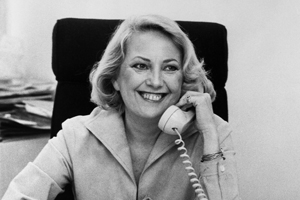The First Lady of Wall Street: Muriel Siebert

1967 was called The Summer of Love. Over the summer months, 100,000 people descended on the Haight Ashbury district in San Francisco. Sounds of The Grateful Dead and Jefferson Airplane dominated the music scene.
Across the country at the corners of Wall Street and Broadway a very different “happening” was taking place. Muriel Siebert became the first woman to buy a seat on the New York Stock Exchange.
There is a reason Muriel Siebert is called the First Lady of Wall Street.
She did not have a college degree. She did not have an MBA from an Ivy League school. She did not come from a wealthy family. There were no “connections.”
After a visit to New York and a trip to the NYSE as it is known, she thought the stock market would be an interesting and exciting place to work. She also thought it would be a place where she would be paid equally to men.
Muriel moved to New York in 1954. She started her career as an entry level equity analyst.
Her research started to attract attention. She had followers and people who wanted to buy or sell the stocks she followed.
Despite the quality of her research she was consistently paid 60% of her male counterparts. When she asked a colleague what large firm she could go to and get paid equally, the response was, “there isn’t one.”
She was told the only way to earn equal pay was to buy a seat on the stock exchange. A seat on the Exchange in 1967 cost $450,000.00.
A gallon of gas in 1967 cost 33 cents.
To become a member of the New York Stock Exchange (NYSE) Muriel had to secure a bank letter of credit for a loan of $300,000.00.
The Catch 22 was that the banks would not lend her the money until the NYSE agreed to admit her. The NYSE would not admit her until she had the loans secured.
In addition to a bank loan, she had to have a sponsor. Of the first 10 men she asked, nine said no.
On December 28, 1967 she joined the 1,365 male members of the New York Stock Exchange.
Muriel opened a brokerage firm that bears her name to this day. Although she railed against discounted commissions, she ultimately became one of the first discount brokerage firms.
Hugh Carey, the governor of the State of New York appointed her Superintendent of Banks in 1977. She was the first woman to hold the position.
To put her appointment in perspective, by 1980 the Fed Funds rate reached 20%. Inflation was 12.5%.
It was the beginning of the Savings and Loan crisis.
Over 1,000 Savings and Loan institutions failed. The Resolution Trust Company closed 747 institutions and the Federal Savings and Loan Company Insurance Company closed 747 financial institutions.
She controlled over 500 banks, $400 billion in assets and $100 billion in trust accounts.
While many banks were failing nationwide not one bank failed under her tenure.
Muriel worked on Wall Street just shy of 50 years. She lived through some of the most interesting times in financial history and she became financial history.
You can see an interview with her from the show Makers.
This website is for informational purposes only and does not constitute an offer to sell, a solicitation to buy, or a recommendation for any security, nor does it constitute an offer to provide investment advisory or other services by The Modest Economist LLC.
